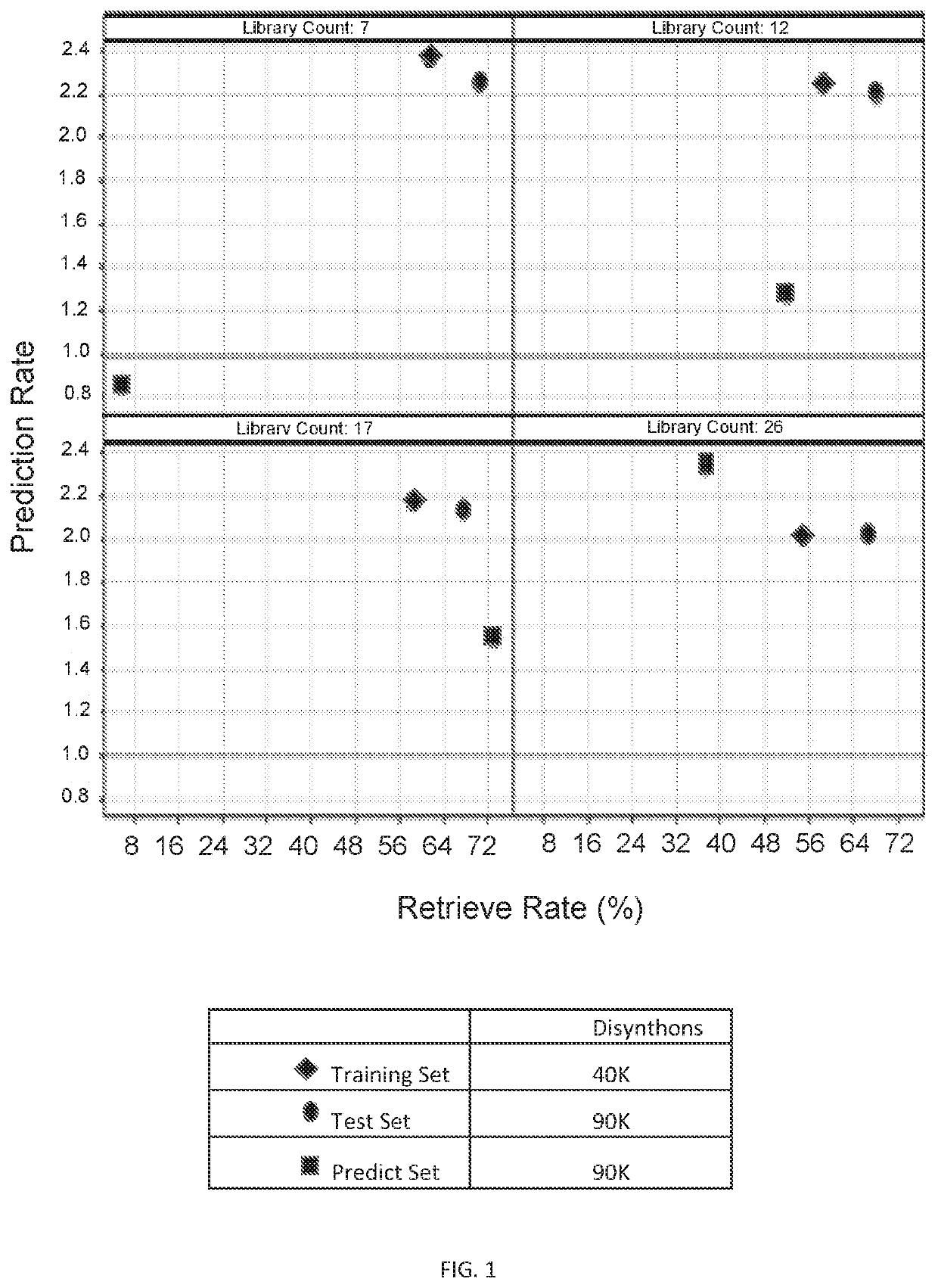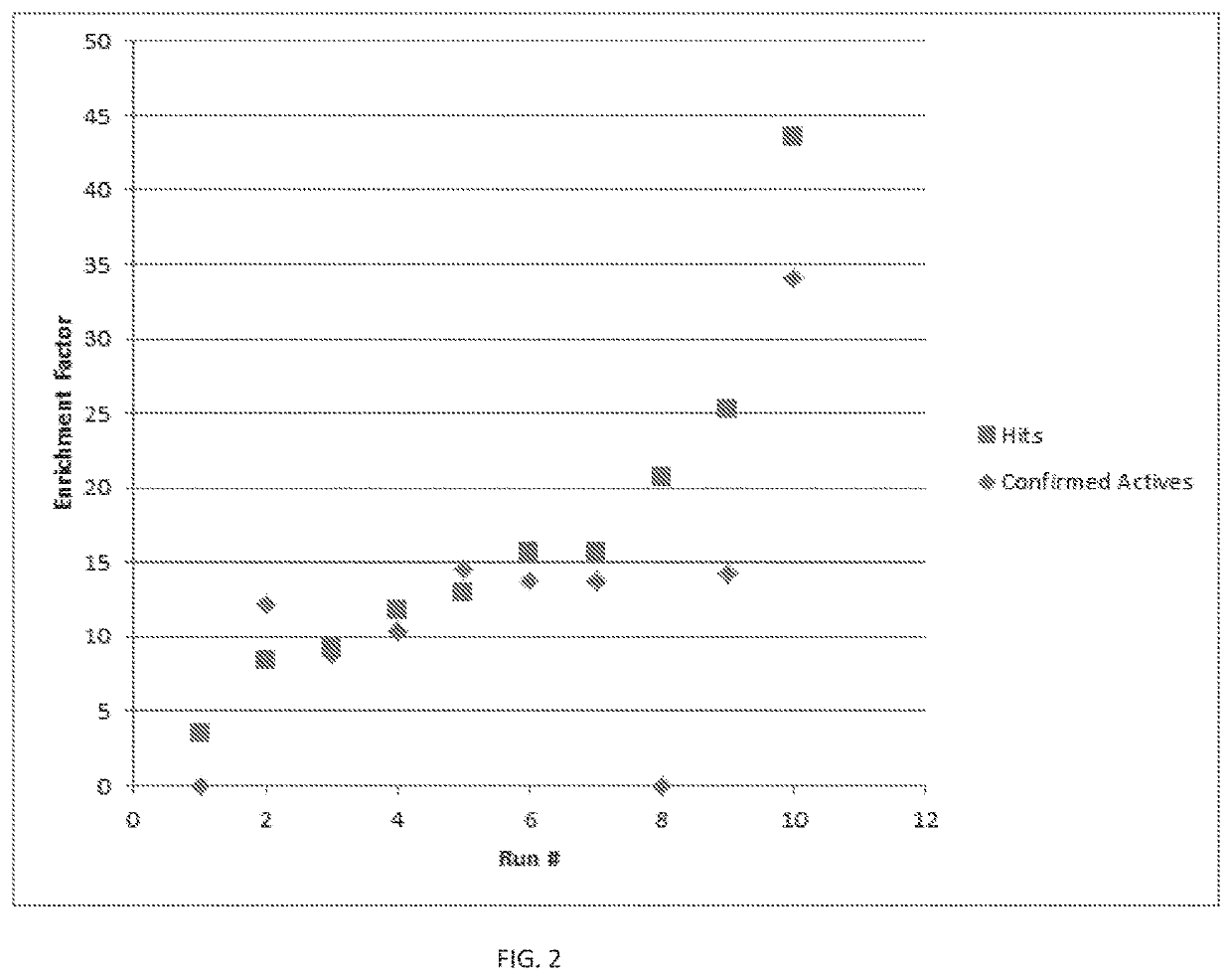Methods for identifying compounds
a compound and compound technology, applied in the field of compound identification, can solve the problem of general limited capacity of virtual screening, and achieve the effect of high confidence prediction
- Summary
- Abstract
- Description
- Claims
- Application Information
AI Technical Summary
Benefits of technology
Problems solved by technology
Method used
Image
Examples
example 1
[0146]Selection data for soluble epoxide hydrolase (sEH) derived from a set of libraries was used to train one of several machine learning models (Random Forest, Naïve Bayes, or Neural Network) and then used to predict the selection behavior of molecules from libraries that were not included in the training set against the same target. The libraries used in the training set included a linear peptide library with 25,844,065 compounds, a 3-cycle pyrazole library with 3,976,320 compounds, a 2-cycle pyridine library with 5,079,459 compounds, and a 4-cycle macrocycle library with 1,511,399,304 compounds. The libraries used in the prediction set included a 3-cycle linear peptide library with 221,580,000 compounds, a 3-cycle pyridine library with 285,917,292 compounds, and a 2-cycle benzimidazole library with 1,622,820 compounds.
[0147]As shown in FIG. 1, enrichment of binders was seen in the predicted set. The 4 quadrants in the graph represent prediction of positive disynthons using incre...
example 2
[0148]Selection data from the same libraries as in Example 1 for a sEH was used with a machine learning algorithm (RF, MLP, deep learning) to train and produce a model that is used to predict activity of molecules not found in the DNA-encoded library. For example, data is fed in and a model is produced that can predict the activity of molecules tested in a traditional high throughput screening (HTS) experiment (i.e., robotic testing of 10 Ks to 1 Ms of molecules). The prediction by the model is applied as a filter to generate a list (e.g., 100s of compounds) from an initial list of 10,000 to 100,000 or more of molecules. The goal is to identify molecules in that short list such that the final list is vastly enriched (10× to 100×) over the underlying rate of active molecules found in the initial set.
[0149]As shown in FIG. 2, enrichment of predicted molecules of >40× over random selection have been observed. FIG. 2 illustrates multiple runs over time as the predictive models were impr...
example 3
ion of Predictions
[0150]A known set of HTS data exists for a given target or targets. Multiple parameter settings are tested in order to achieve high prediction rates. In effect, the high prediction rate is a result of tuning to the prediction to the HTS results. Using HTS to confirm applicability, the model can then be used to predict novel compounds or existing compounds (e.g., commercially available or from a preexisting private compound library). These molecules can then be tested with the expectation of higher rate of actives, e.g., greater than 1% or 10% active molecules within the predicted set regardless of the underlying active rate of a random sample.
PUM
| Property | Measurement | Unit |
|---|---|---|
| dissociation equilibrium constant | aaaaa | aaaaa |
| dissociation equilibrium constant | aaaaa | aaaaa |
| dissociation equilibrium constant | aaaaa | aaaaa |
Abstract
Description
Claims
Application Information
 Login to View More
Login to View More - R&D
- Intellectual Property
- Life Sciences
- Materials
- Tech Scout
- Unparalleled Data Quality
- Higher Quality Content
- 60% Fewer Hallucinations
Browse by: Latest US Patents, China's latest patents, Technical Efficacy Thesaurus, Application Domain, Technology Topic, Popular Technical Reports.
© 2025 PatSnap. All rights reserved.Legal|Privacy policy|Modern Slavery Act Transparency Statement|Sitemap|About US| Contact US: help@patsnap.com


